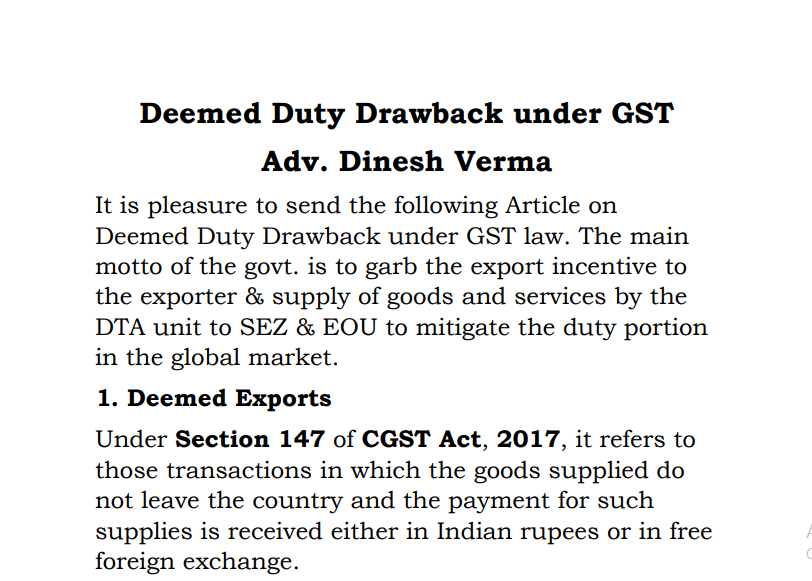Deemed Duty Drawback under GST
Table of Contents
Deemed Duty Drawback under GST
It is a pleasure to send the following Article on Deemed Duty Drawback under GST law. The main motto of the govt. is to garb the export incentive to the exporter & supply of goods and services by the DTA unit to SEZ & EOU to mitigate the duty portion in the global market.
1. Deemed Exports
Under Section 147 of the CGST Act, 2017, it refers to those transactions in which the goods supplied do not leave the country and the payment for such supplies is received either in Indian rupees or in free foreign exchange.
2. Essential conditions of Deemed Exports
i. It is applicable only to the supply of goods.
ii. The supply of goods should only be in India.
iii. The supply of goods is only to the registered person.
iv. The supply of goods must be fall under Section 147 of the CGST Act, 2017.
v. Payment of supply of goods is either received in Indian currency or in foreign exchange.
3. Documents Required for Claiming Refund on Exports
1. Copy of return evidencing payment of duty
2. Copy of invoice
3. Document proving that the burden of paying tax has not been passed on (CA certification or self-certification).
4. Any other document required by the government.
Related Topic:
Show Cause Notice Under GST Regime
4. What is Duty Drawback?
Under GST, the duty drawback would only be available for the customs duty paid on imported inputs or central excise paid on certain petroleum or tobacco products used as inputs or fuel for captive power generations.
5. Duty Drawback Scheme
The duty drawback scheme seeks to rebate duty or tax chargeable on any imported/excisable materials and inputs services used in the manufacture of export goods.
The duty Drawback is of three types:-
i) All Industry Rates
ii) Brand Rates
iii) Special Brand Rates
i) All Industry Rates
The All industry Rates (AIR) is essentially an average rate based on the average quantity and value of inputs and duties (both excise and customs) borne by them and service tax suffered by particular export products.
All Industry Drawback rates are fixed under Rule 3 of Drawback Rules by considering the average quantity and value of each class of inputs imported. The average amount of customs duties is considered. These rates are fixed for broad categories of products. The rates include drawbacks on packing materials.
All industry duty drawback rates shall not exceed 33% of the market price of export goods- rule 9 of Customs and Central Excise Duties Drawback Rules, 2017.
Related Topic:
Reversal of service tax credit on receipt of completion certificate by a developer in GST Regime – A Controversy
ii) Brand Rate
It is possible to fix the All Industry Rate only for some standard products. It cannot be fixed for special types of products. In such cases, the brand rate is fixed under rule 6 of Customs and Central Excise Duties Drawback Rules, 2017.
The provisional drawback can be obtained in the execution of bonds. The provisional rate can be fixed under rule 6(2) of Customs and Central Excise Duties Drawback Rules, 2017 by the principal commissioner/commissioner of customs.
According to Rule 9, Duty Drawback Rate shall not exceed 33% of the market price of export goods.
iii) Special Brand Rates
All industry Rates are fixed on an average basis. Thus, a particular exporter may find that the actual customs duty paid on inputs is higher than all industry Rates fixed for his product. In such a case, he can apply under Rule 7 of Customs and Central Excise Duties Drawback Rules, 2017 for fixation of Special Brand Rate, within three months from export
Related Topic:
Ppt on Accounting & Closing of Books under GST regime
6. Duty Drawback under GST
A duty drawback was provided under the previous laws for the tax paid on inputs for the export of exempted goods. Claiming the duty drawback was a cumbersome process. Under GST, the duty drawback would only be available for the customs duty paid on imported inputs or central excise paid on certain petroleum or tobacco products used as inputs or fuel for captive power generation. There was some confusion surrounding the refund of the tax paid by exporters on the inputs.
No amendments have been made to the drawback provisions (Section 74 or Section 75) under the Customs Act 1962 in the GST regime. Hence, the drawback scheme will continue in terms of both Section 74 and Section 75. The option of All Industry Rate (AIR) as well as Brand Rate under Section 75 shall also continue.
Drawback under Section 74 will refund Customs duties as well as Integrated Tax and Compensation Cess paid on imported goods which are re-exported.
At present Duty Drawback Scheme under Section 75 neutralizes Customs duty, Central excise duty, and Service Tax chargeable on any imported materials or excisable materials used or taxable services used as input services in the manufacture of export goods. Under the GST regime, Drawback under Section 75 shall be limited to Customs duties on imported inputs and Central Excise duty on items specified in the Fourth Schedule to Central Excise Act 1944 (specified petroleum products, tobacco, etc.) used as inputs or fuel for captive power generation.
A transition period of three months is also being provided from the date of implementation of GST. During this period, the existing duty drawback scheme under Section 75 shall continue. For exports during this period, exporters can claim a higher rate of duty drawback (composite AIR) subject to conditions that no input tax credit of CGST/IGST is claimed, no refund of IGST paid on export goods is claimed and no CENVAT credit is carried forward. A declaration from exporter and certificate from jurisdictional GST officer in this regard has been prescribed in the notification related to AIRs. This will prevent double availement of the neutralization of input taxes. Similarly, the exporter can claim the brand rate for Customs, Central Excise duties, and Service Tax during this period.
Exporters also have the option of claiming only the Customs portion of AIR and claim refund/ITC under GST laws.
The certificates from the jurisdictional GST officers as referred above may not be available during initial days. As per Systems design, whenever a higher rate (composite rate) of drawback is claimed, the non-availment of credit certificate is a mandatory document and unless it is recorded as available, the shipping bill will not move to the LEO stage. In such a situation, all field formations shall ensure that exports are not delayed for the requirement of the said certificate. The way out in such a situation for the exporter is to amend the shipping bill to claim a lower rate. The exporter will have an option to file a supplementary claim as per Drawback Rules at a later date once the certificate is obtained.
Secondly, it could be possible that export goods may be manufactured by using both Central Excise/Service Tax paid and CGST/IGST paid inputs and inputs services or only CGST/IGST paid inputs and inputs services. In such a situation, an exporter opting to claim a composite rate of duty drawback during the transition period has to give a specified declaration and produce certificates as stated above so that he does not claim double benefit. The exporter will have to reverse the ITC if any availed and also ensure that he does not claim a refund of ITC/IGST. The requisite certificate from the GST officer shall also be required for this effect. As mentioned earlier, exporters will also have the option of claiming credit/refund of CGST/IGST and claim Customs rate drawback.
7. Conclusion
Duty drawback provisions are made to grant rebate of duty or tax chargeable on any imported/excisable materials and inputs services used in the manufacture of export goods. With GST in place, the export industry in India would be able to have internationally competitive prices due to the smooth process of claiming input tax credit and the availability of input tax credit on services.
 Advocate Dinesh Verma
Advocate Dinesh Verma









